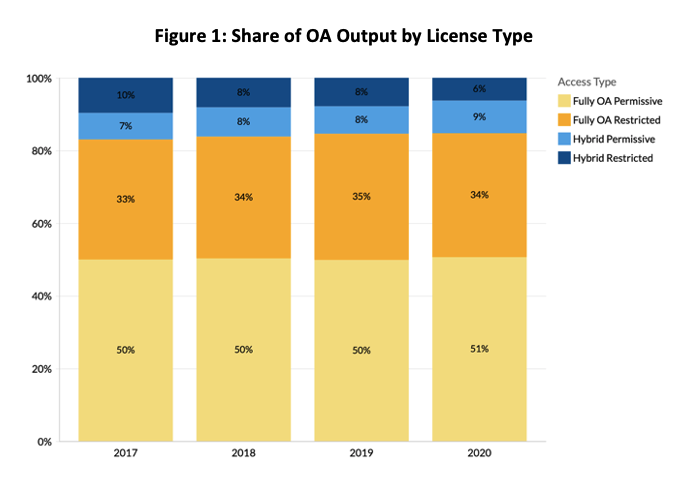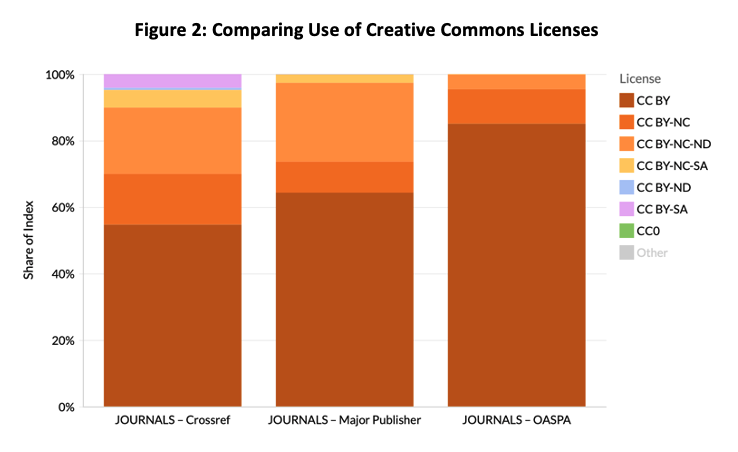This month we revisit the types of licenses attached to open access publications. We examine the balance between more or less permissive licenses, and the patterns make for interesting reading.
Introduction
Last year we examined the use of different sorts of OA licenses. We noted that formal definitions of open access require that articles are both free of charge and from reuse restrictions. Creative Commons licenses have become the de facto standard for open access publications, but the licenses offer a range of permissions. For the purposes of analysis we define:
- “Permissive” as articles published under CC BY (attribution only required) or CC0 (no restriction). CC BY is typically the license required by major funders of OA, such as Plan S, Wellcome, HHMI, etc.
- “Restricted” as articles published under other licenses that allow restricted reuse, such as CC BY-NC (non-commercial), CC BY-ND (no derivative), or publisher-specific licenses. Although not conforming to the strictest OA mandates, such licenses are widely used and are consistent with many OA requirements. Publishers sometimes charge lower APCs for these more restrictive licenses compared with their permissive counterparts.
The use of these licenses types in open access is shown in the following figure.

The chart splits these licenses between content in fully OA journals (in yellow), and the OA content in other journals (“hybrid” – in blue).
- Overall, the Permissive licenses (CC0, CC BY – the paler colors) are most commonly used, outnumbering more restrictive ones by around 3:2.
- Within fully OA journals, the ratio is similar to the overall average, compared with an even split in hybrid publications.
- Long-term trends (not shown here) suggest that fully OA output and the use of permissive licenses is slowly gaining share.
- The underlying data has changed since last year. This year’s data shows greater numbers of fully OA journals, with a slightly greater prevalence of permissive licenses.
Variations by Discipline
Looking at our full data set, which allows for deeper analysis, breaking the data out by publisher and discipline shows that patterns of use vary. For example:
- Larger publishers with mixed portfolios of fully OA and hybrid journals publish a greater proportion of their output in hybrid journals. They also publish a significantly greater proportion of their output under more permissive licenses.
- Figures vary between disciplines. For example, Health Sciences shows a similar uptake of fully OA, but a greater leaning towards more restricted licenses. Environmental Sciences shows a similar uptake of fully OA, but greater leaning towards permissive licenses.
- Users of our Open Access Data and Analytics Tool can explore these details further.
Analyzing Specific Creative Commons Licences
We have worked with OASPA on their annual survey again this year. We put together a blog post to show the results. This year we have also expanded our own analysis. The chart below compares some different sources, including our analysis of journals, OASPA members, and the Directory of Open Access books (which we have previously covered in greater depth).

The chart above shows the combined output of various indexes from 2015 – 2020.
- Across the whole of Crossref (the leftmost bar), just under 55% of OA output is published under CC BY license. The non-commercial, no derivatives CC BY-NC-ND is next most prevalent at 20%.
- The large publishers (middle bar) make greater use of CC BY (just under 65% of their output) and slightly more of CC BY-NC-ND (23%).
- OASPA publishers make far greater use of CC BY (85% of output), with very little CC BY-NC-ND. They publish a significantly greater proportion of their output under more permissive licenses compared with the market-wide averages.
Conclusion
The data support what many of us know from anecdotal discussions. The majority of OA output is published under more permissive licenses. In particular the CC BY license dominates, especially in fully OA journals, and especially by OASPA members. It’s useful to see this confirmed across the market, and also to see how the figures differ for the large publishers.
However, licenses that allow sharing with some restrictions remain significant and show no signs of collapsing. Many publishers continue to make use of them. In fact, restricted licenses cover the majority of output in some disciplines. Subscribers to our database can examine this in more detail and also look at longer term trends.
Of course, we have yet to see the effects of large-scale mandates such as Plan S. Common sense suggests that the proportions of CC BY licensed output are likely to increase, and we look forward to revisiting the data in the coming months and years.
This article is © 2022 Delta Think, Inc. It is published under a Creative Commons Attribution-NonCommercial 4.0 International License. Please do get in touch if you want to use it in other contexts – we’re usually pretty accommodating.

TOP HEADLINES
UNESCO Recommendation on Open Science: a response from cOAlition S – January 12, 2022
“cOAlition S welcomes the landmark UNESCO Recommendation on Open Science that was adopted at the 41st session of its General Conference in November 2021. The document provides an international framework where Open Science is viewed as a global public good, and where the equitable sharing of scholarly results is the default.”
GDC Difusión Científica launches F1000’s first open access publishing hub in Latin America – January 11, 2022
“GDC Difusión Científica has partnered with open research publisher F1000 to create a dedicated open research publishing hub, GDC Open Research in Latin America. This Gateway will enable researchers to amplify the impact of their work and promote the principles of open research throughout Latin America and beyond.”
Newly launched searchRxiv builds search community to foster easier, quicker research – December 17, 2021
“This week, CABI launched searchRxiv (pronounced ‘search archive’), our new open-access platform. We created the website to help researchers report, store and share their searches consistently. This helps with the review and re-use of existing searches, making research quicker and easier.”
cOAlition S starts building its Journal Comparison Service to help create visibility of publishing services and prices – December 16, 2021
“cOAlition S is pleased to announce that work has commenced on building the Journal Comparison Service to help the research community better understand if the publishing fees they pay are commensurate with the services delivered and to gain better insight into the elements of those services.”
OA JOURNAL LAUNCHES
December 17, 2021 | “The eScholarship Publishing program at the University of California is delighted to announce the publication of the first issue of Combinatorial Theory, a new open access journal focused on mathematical research in Combinatorics, with applications throughout the mathematical, computational and natural sciences.” | |
December 16, 2021 | The Electrochemical Society launches two new gold open access journals with IOP Publishing | “The Electrochemical Society (ECS), together with IOP Publishing, is launching two new, fully open access (OA) journals. ECS Advances and ECS Sensors Plus add to the Society’s journal family and provide the research community with a diverse suite of interconnected journals sharing impactful research across the world.” |


DISCUSSION
Comments are closed.